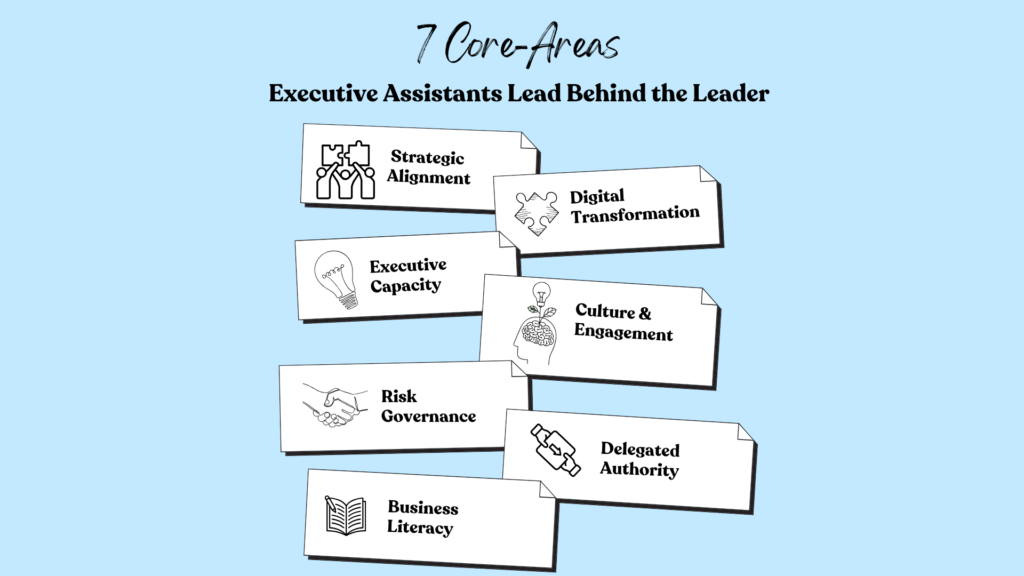
Julia Schmidt, author of The Executive Support Guide to Building a Successful Career Strategy,explains the critical role of Assistants in modern leadership
In this inspiring piece, Julia Schmidt challenges Assistants to recognise their powerful influence in shaping outcomes, culture, and strategy. Against a backdrop of rapid change, evolving technology, and the rise of AI, she urges EAs to embrace reinvention, upskilling, and ownership of their leadership journey. With practical examples and self-reflective questions, Julia empowers us to lead with intention, not by title, but by action.
If you keep projects on track, spot risks before they explode, or calm a tense room with a single sentence, you’re doing far more than “support.” You’re leading. Your email signature may read Assistant, but the influence you wield shapes decisions, culture, and results every single day. You are the leader behind the leader.
“Leaders are facing an unprecedented set of challenges as they work to run their companies, and EAs are supporting them to bring order to the chaos,” writes workplace expert Bonnie Low-Kramen in Harvard Business Review. As the Assistant role has evolved, we now share the leadership seat with our executives.
How many times have you heard a colleague introduce you as the “most important person in the company after your executive,” the “CEO’s secret weapon,” or even the “glue that holds everything together”? We are leading, even if our job titles don’t say so.
Defining Leadership
But what is leadership, and who is a leader? There are many possible answers! In his book The Future Leader: 9 Skills and Mindsets to Succeed in the Next Decade, best-selling author Jacob Morgan references interviews he conducted with over 140 of the world’s top CEOs, from companies such as Yahoo, Mastercard, Oracle, Avanade, SAP, KPMG, and many others. Among the seven questions Morgan asked CEOs, one was related to defining leadership. All 140 CEOs defined leadership differently, and for some of them, leadership is about:
- turning vision into reality through people
- setting a clear direction and clearing the path
- modeling the behavior you expect from others
- building leaders who will one day replace you
- translating strategy into daily actions
- empowering people and enabling growth
- achieving high performance or driving business results
The word “lead” can be traced back to the year 900 and means “to go before or with, to show the way.” Therefore, we could say that all the answers above are examples of how you can go before or with others to show the way. Morgan concluded that leadership is defined differently depending on the leader and the organization, highlighting the impact that groups, teams, and organizations have on us as individuals. “This means that the first step to becoming or creating a great leader is to define what leadership means and how it comes to life inside your organization (and/or your personal life),” he explains.
The Transformative Power of AI
In the McKinsey & Company report, Superagency in the workplace: Empowering people to unlock AI’s full potential (April 2025), the authors note that, over the next three years, 92% of companies plan to increase their AI investments. That means most CEOs now treat AI as a strategic focus area. We will thrive in this digital era only if we engage with excitement and curiosity, and embrace the ideas and opportunities that digital tools, data analysis, and AI technologies bring to us and to society as a whole.
5 Questions to Ask Yourself About AI
- Am I serving as an AI catalyst in my workplace and leading projects that deliver training for employees?
- Am I creating platforms for learning and sharing in my workplace?
- Am I identifying areas where technology can add value to employees rather than replace them?
- Am I experimenting with new technologies on an ongoing basis and becoming familiar with what they are, what they do, and how they work at a high level?
- Am I viewing AI and technology as partners to my organization?
The Pace of Change and Need for Permanent Reinvention
Workplace practices are changing rapidly. “In 1958, the average Fortune 500 company lasted 61 years. By 1980? 35 years. By 2016? 24 years. And in 2025, that number is projected to be just 15 years. By 2030, businesses will be lucky to last 10 years before disappearing.” (Reinvention Academy)
Technologies become obsolete, and new ones evolve at high speed. As an example, the user-facing features of ChatGPT are refreshed roughly every two weeks, and features or model refinements appear about once a month. What worked for leaders in the past will not necessarily work today or in the future of work. Leadership itself is changing and requires constant reinvention.
5 Questions to Ask Yourself About Change
- Am I experimenting with and testing new ideas frequently?
- Do I feel comfortable challenging the status quo instead of clinging to “we have always done things like this”?
- Am I surrounding myself with people who are smarter and more capable than I am?
- Am I building alliances with people and organizations?
- Am I challenging outdated workplace policies, procedures, and rules that prevent my organization from succeeding in the future?
Reinvention is the key to adaptability and employability in a world of constant change. To survive the speed and uncertainty of change, we need to turn it into great opportunities for our own growth and development and to make ourselves capable of guiding the people around us. A great leader is a great guide.
The Need to Upskill and Reskill the Workforce
The talent landscape is shifting, and every leader must help attract and retain the best people. A great leader knows how to identify talented individuals, recruit them, and keep them motivated. People who are already onboard and have been in the company for a while will also need to face the need for upskilling and reskilling. They may resist and get lost along the way, but you, as a leader, have to guide them and help them understand the need to reinvent themselves.
5 Questions to Ask Yourself About Upskilling and Reskilling
- Am I helping my company design reskilling and upskilling programs for executive support professionals?
- Am I supporting employees in understanding how their careers and jobs are changing and what skills they need to remain relevant and valuable members of the company?
- Am I supporting the company in building a diverse and inclusive workforce?
- Am I enabling collaboration and effective communication among teams?
- Am I tracking progress and celebrating achievements in our upskilling and reskilling initiatives?
Many organizations hire people for their current expertise and rarely provide opportunities for further expansion. As a leader, you don’t want that for yourself or for anyone else in your company. You know that when the prospect for growth is limited, your best colleagues will leave to pursue it elsewhere. As people develop new capabilities, so too does the organization.
Going Before – And With – To Show the Way

Here are seven concrete examples showcasing how Assistants can strategically enable effective leadership through everyday actions.
1. Strategic Alignment
After a quarterly board meeting, an Assistant distils a 70-page board pack into a three-page executive brief and an action log with owners and deadlines. They embed those deadlines in each leader’s calendar and schedule a 10-minute “decision review” at the next executive meeting. This single intervention clarifies priorities, accelerates follow-through, and frees the CEO to focus on external stakeholders. By translating strategy into concrete tasks and enforcing accountability, the Assistant demonstrates core leadership behaviors, aligning people and activating execution.
2. Digital Transformation
When the organization adopts a new AI-enabled scheduling platform, the Assistant pilots the tool, maps the workflow implications, and creates a short tutorial for department coordinators. Adoption climbs from 20% to 85% within six weeks, saving managers an estimated eight hours per month. The Assistant’s influence changes both practice and productivity without formal authority.
3. Executive Capacity
A CFO is overwhelmed by meeting requests during a volatile merger and acquisition (M&A) negotiation. The Assistant audits each invitation against the deal’s critical path. Non-essential meetings are channelled to deputies; urgent issues are grouped into a single daily “war-room” slot. The CFO regains four hours a day for negotiation preparation. The Assistant has applied the prioritization, stakeholder management, and delegation competencies expected of a strategically-minded employee.
4. Culture and Engagement
During a period of cost-cutting, morale dips. The Assistant launches a weekly “Wins and Learnings” digest that highlights small team victories and candid lessons. They coordinate brief shout-outs from the CEO, reinforcing psychological safety and recognition. Employee engagement pulse scores rise 12 points within a quarter – evidence that leadership impact can flow from empathetic, culture-building behaviors rather than positional power.
5. Risk and Compliance
In preparation for an annual regulatory audit, the Assistant reviews policy updates, schedules mandatory training, and tracks completion rates across functions. They escalate gaps well before the deadline, averting costly penalties. In leadership research, this is called “initiating structure”: setting clear rules, defining tasks, and making sure everyone knows who does what and by when. By creating that structure, the Assistant protects organizational health and keeps risk firmly under control.
6. Delegated Authority
When the CEO is abroad, the Assistant chairs the weekly executive alignment call, armed with pre-approved decision thresholds. They resolve routine issues on the spot and flag only high-risk items for the CEO’s input. By maintaining the leadership rhythm and representing the principal, they embody the distributed-leadership model in which authority flows to the person best equipped for the task.
7. Business Literacy
Survey feedback shows employees want clearer visibility into business performance. In a leadership meeting, the Assistant proposes a bimonthly newsletter to showcase major deals and team successes. They design and launch the first issue within a month, and six years later the newsletter still posts an open rate 30% above industry norms, engaging every department and sharpening company-wide business awareness. By identifying an information gap, crafting a solution, and sustaining a high-value channel that boosts transparency and cross-functional recognition, the Assistant demonstrates the core leadership behaviors of inspiring through communication, aligning teams around shared business knowledge, and activating ongoing engagement.
Taking Ownership
Assistants are co-leading together with their executives and managers. Your leadership journey starts with staying aligned to your company’s vision and mission, and understanding its definition of leadership, what it means to be a leader, and the skills and mindsets required to succeed. If you don’t fully grasp these things, how can you become the leader you want and are expected to be? You have to start somewhere. If that starting point isn’t your company’s leadership definition aligned with your own, then begin by asking yourself first.
5 Questions to Ask Yourself About Leadership
- Do I see myself as one of the Assistants in the examples above?
- Which leadership story would I like to claim?
- What do I think it means to be a leader?
- What kind of leader do I want to become?
- What skills and mindset will I need to succeed as a leader?
Anyone can become a leader; it’s a matter of understanding whom you are leading. You can lead yourself, a small team of Assistants, a function, a department, or an entire association of administrative professionals. Each leadership role demands a different set of skills and mindsets. If you do not succeed in embracing the capabilities required to lead people, you risk putting yourself in a position to fail.
Take ownership! If you already hold a leadership position as an Assistant and feel that you lack the skills and mindsets your company expects, it is your responsibility to learn and practice them; otherwise, you will lose your unique opportunity to lead from where you are now.
We live in a vulnerable, uncertain, complex, and ambiguous (VUCA) world. The business landscape is changing quickly, which forces us to keep strengthening our leadership skills and mindsets. What made you successful as a leader yesterday will not necessarily make you successful today, or in the future. Leadership is a learning curve. Every executive I have worked with was willing to partner with an Assistant who could lead, serving as both pilot and co-pilot.
It’s time to step out of your comfort zone and let the leader in you flourish. This is both a learning and a growth opportunity. You may already be on this journey, but perhaps not embracing it strategically. Draw inspiration from the leadership behaviors and actions shared in this article and create your own leadership roadmap.
What can you do today to become one of the EA leaders highlighted here? Now it’s your turn to become a great leader. It’s not about your title; it’s about how you show up to work every day. And if you are already there, shining as a great leader, your responsibility is to encourage other executive support professionals to unlock their leadership power. We need more great EA leaders, so don’t tell me you are not a leader!










